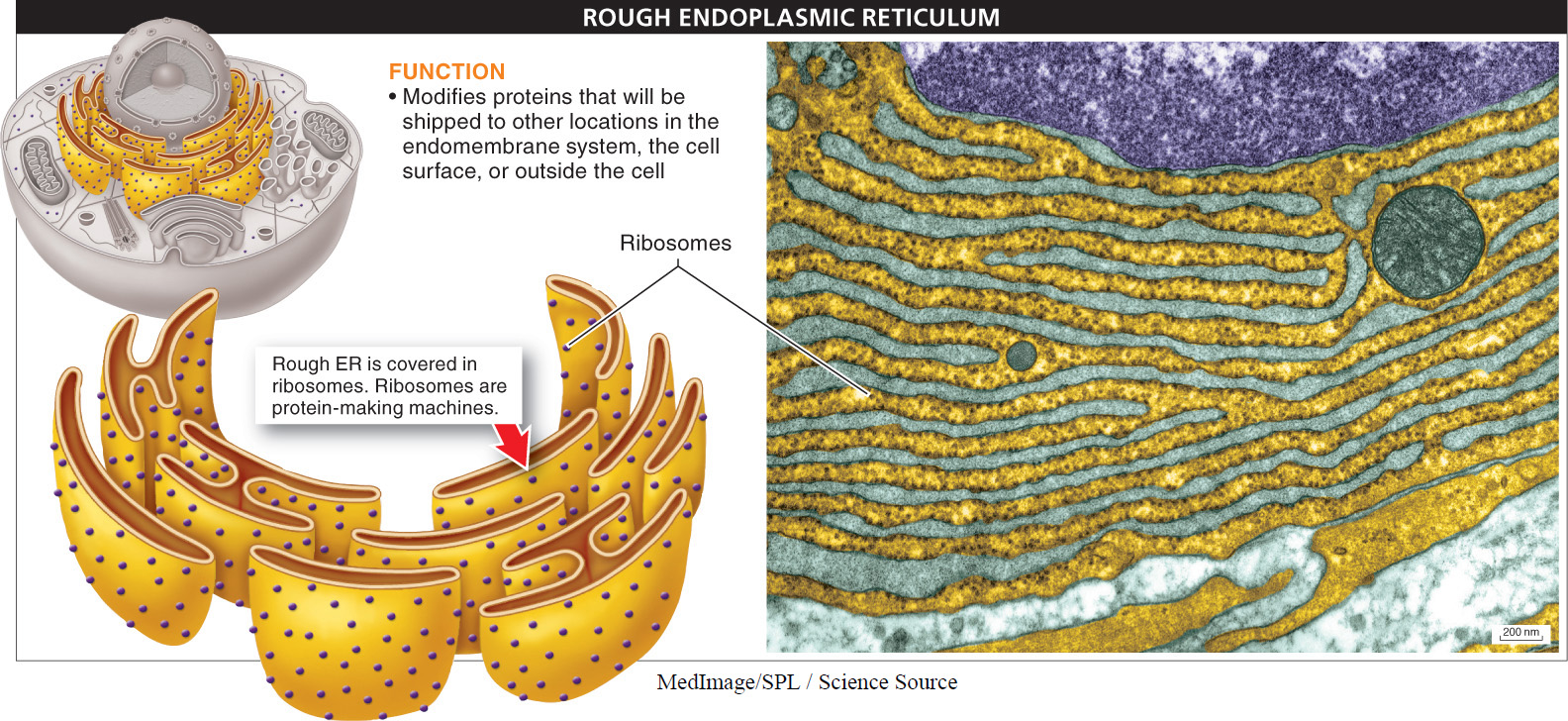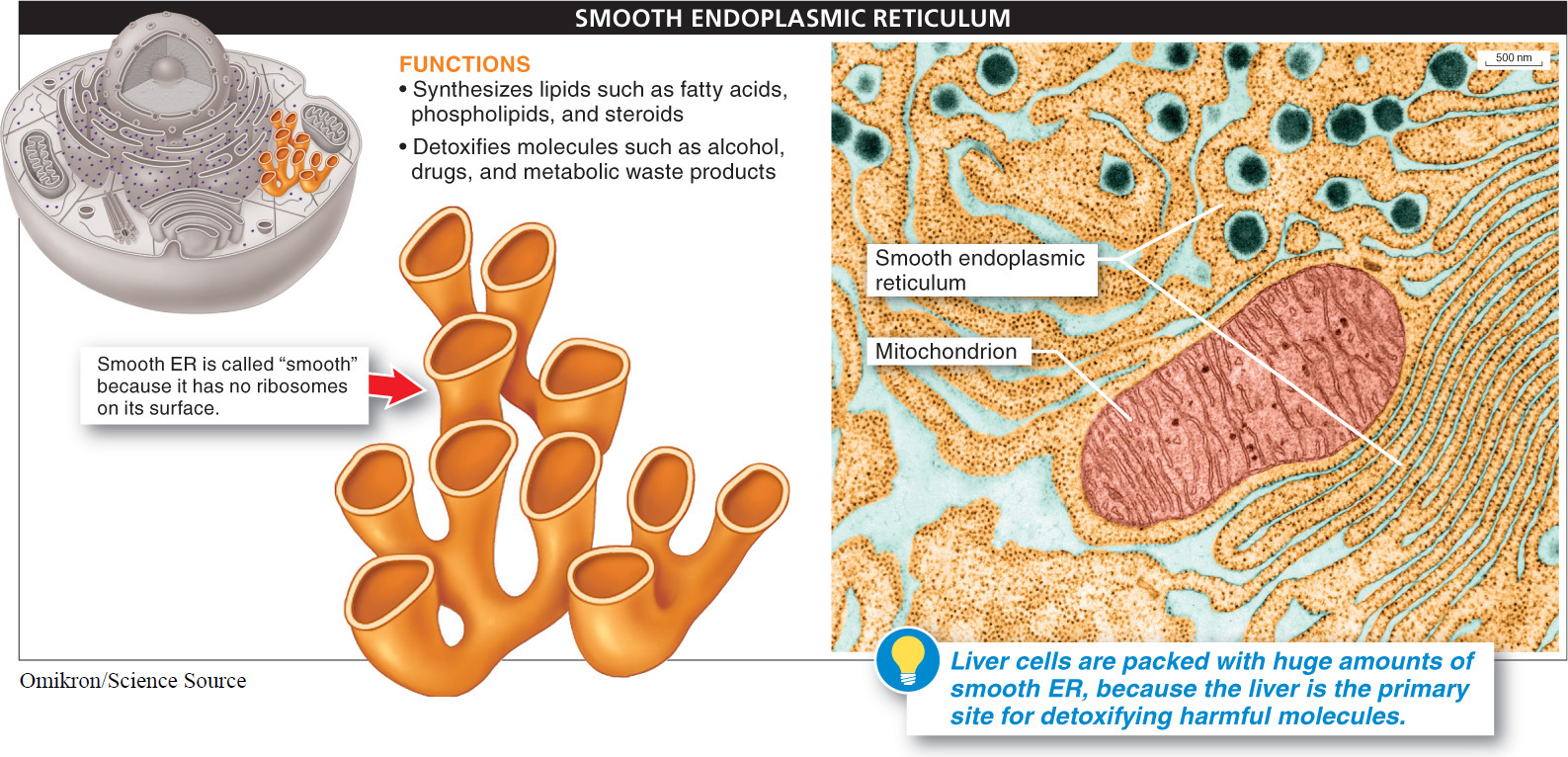3.18: In the endoplasmic reticulum, cells build proteins and lipids and disarm toxins.
The information for how to construct the molecules essential to a cell’s smooth functioning and survival is stored in the DNA found in the cell’s nucleus. The energy used to construct these molecules and to run cellular functions comes primarily from the mitochondria. The actual production and modification of biological molecules, however, occurs in a system of organelles called the endomembrane system (FIGURE 3-34). This mass of interrelated membranes spreads out from and surrounds the nucleus, forming chambers within the cell that contain their own mixtures of chemicals. The endomembrane system takes up as much as one-

Polypeptide chains are assembled into functional proteins and lipids are produced within the membrane-
Because the process of protein production follows a somewhat linear path, we explore the endomembrane system sequentially, beginning just outside the nucleus with the endoplasmic reticulum.
Rough Endoplasmic Reticulum Perhaps the organelle with the most cumbersome name, the rough endoplasmic reticulum, or rough ER (“endoplasmic reticulum” is derived from the Greek for “within” and “anything molded” and the Latin for “small net”), is a large series of interconnected, flattened sacs that look like a stack of pancakes. These sacs are connected directly to the nuclear envelope. In most eukaryotic cells, the rough ER almost completely surrounds the nucleus (FIGURE 3-35). It is called “rough” because its surface is studded with little bumps. These bumps are ribosomes, the cell’s protein-

The primary function of the rough ER is to fold and package proteins that will be shipped to other locations in the endomembrane system, on the cell surface, or outside the cell. Poisonous frogs, for example, package their poison in the rough ER of the cells where it is produced before transporting it to the poison glands on their skin. Proteins that are used within the cell itself are generally produced on free-
Smooth Endoplasmic Reticulum As its name advertises, the smooth endoplasmic reticulum, or smooth ER, is part of the endomembrane network that is smooth, because there are no ribosomes bound to it (FIGURE 3-36). Although it is connected to the rough ER, it is farther from the nucleus and, besides lacking ribosomes, differs slightly in appearance. Whereas the rough ER looks like stacks of pancakes, the smooth ER sometimes looks like a collection of branched tubes.

The smooth surface gives us the first hint that smooth ER has a different job than rough ER. Because ribosomes are absolutely essential for protein production, we can guess that, with few ribosomes, the smooth ER is not extensively involved in folding or packaging proteins. It isn’t. Instead, it primarily takes part in the synthesis of lipids such as fatty acids, phospholipids, and steroids, as well as carbohydrates. Exactly which lipids are produced varies throughout the organism and across plant and animal species. Inside the smooth ER of mammalian ovaries and testes, for example, the hormones estrogen and testosterone are produced. Inside the smooth ER of liver and fat cells, other lipids are produced. Following the same packaging process that occurs for proteins in the rough ER, lipids produced by the smooth ER are packaged in transport vesicles and then sent to other parts of the cell or to the plasma membrane for export.
121
122
Another critical responsibility of the smooth ER—
As we see over and over in living organisms, form follows function. Not surprisingly, then, just as cells with high rates of protein production have large numbers of ribosomes, we find huge amounts of smooth ER in liver cells because they are the primary sites of molecular detoxification. Other cells that are packed with ER (both rough and smooth) include plasma cells in the blood that produce immune system proteins for export and pancreas cells that secrete large amounts of digestive enzymes.
Chronic exposure to many drugs (from antibiotics to heroin) can induce a proliferation of smooth ER, particularly in the liver, and of the smooth ER’s associated detoxification enzymes. This proliferation in turn increases tolerance to the drugs, necessitating higher doses to achieve the same effect. This increased detoxification capacity of the cells often enables them to better detoxify other compounds, even if the person has never been exposed to these chemicals. This increased detoxification capacity can lead to problems. An individual who has been exposed to large amounts of certain drugs, for example, may end up responding less well to antibiotics.
Q
Question 3.10
How can long-
TAKE-HOME MESSAGE 3.18
The production and modification of biological molecules in eukaryotic cells occurs in a system of organelles called the endomembrane system, which includes, among other organelles, the rough and smooth endoplasmic reticulum. In rough ER, proteins that will be shipped elsewhere in the body are folded and packaged. In the smooth ER, lipids and carbohydrates are synthesized and alcohol, antibiotics, and other drugs are detoxified.
List the two divisions of the endoplasmic reticulum and at least one function of each.